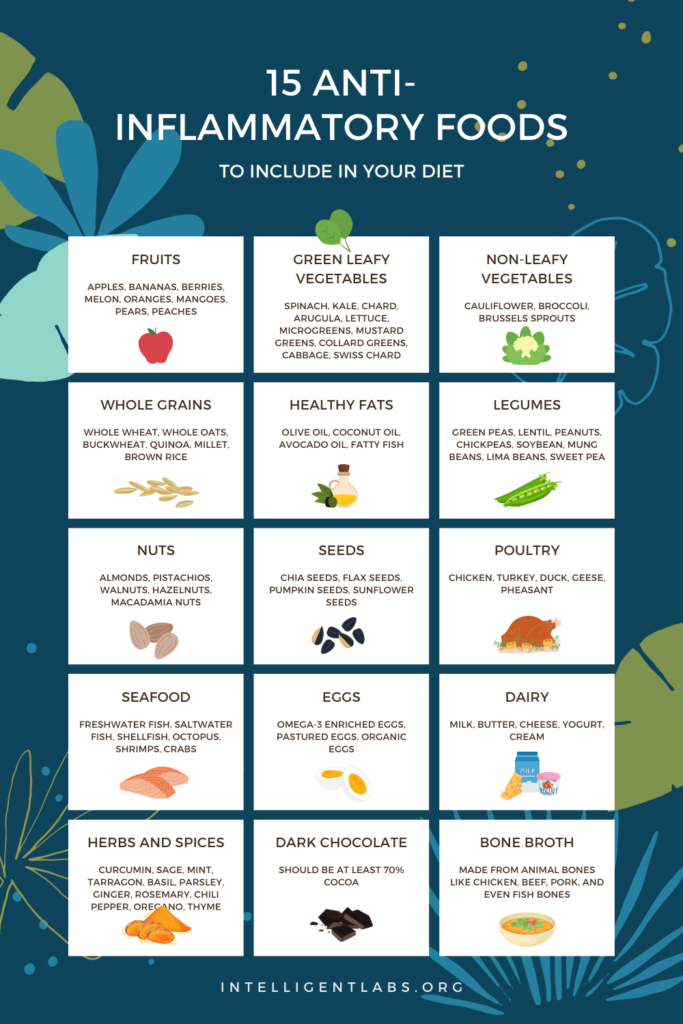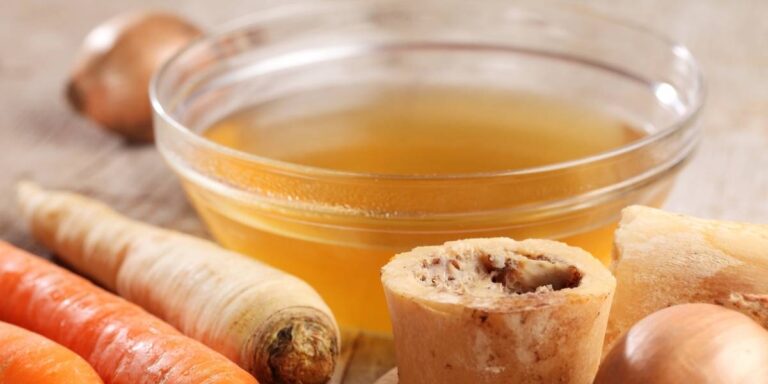15 Anti-Inflammatory Foods To Include In Your Diet
Inflammation is a vital component of your body’s immune response. Think of it as your body’s way of telling you that it’s doing its job fighting off intruders, which is a great thing! Acute or short-term inflammation is GOOD, but chronic inflammation is BAD. While there are modern drugs and supplements that can treat inflammation, we’ll focus on the diet side of things. Today, we’ll talk about the top 15 anti-inflammatory foods that can help manage chronic inflammation symptoms.
What are the health risks associated with chronic inflammation?
Chronic inflammation – which can go on for years – can pose a serious threat to your health. It drastically increases the risk for many diseases 1 2, such as:
| Type 2 diabetes | Hypertension | Arthritis and joint disease |
| Cardiovascular disease | Chronic kidney disease | Depression |
| Allergies | Cancer | Metabolic syndrome |
| Polycystic ovary syndrome (PCOS) | Non-alcoholic fatty liver disease (NAFLD) | Chronic obstructive pulmonary disease (COPD) |
So, what exactly is behind chronic inflammation?
- A diet rich in pro-inflammatory foods like refined carbs, deep-fried food, sugar-sweetened beverages, soda, red meat, processed meat, artificial trans-fat, and vegetable oils.
- Age
- Lack of physical activity
- Obesity
- Tobacco smoking
- Stress
- Sleep disorders
- Exposure to environmental and industrial pollutants
Why is eating anti-inflammatory foods a must for those with chronic inflammation?
As the name suggests, anti-inflammatory foods are healthy, nutritious foods that reduce inflammation levels in the body. They usually come in the form of whole foods, NOT processed foods. Whole foods are minimally processed, single-ingredient foods that do not contain a ton of sugar, additives, and preservatives. They typically go straight from farm to table, still bursting with freshness, flavor, and nutrients!
Anti-inflammatory medications like corticosteroids do help, but when taken long term, they can have a lot of undesirable side effects 5. This is why switching to an anti-inflammation diet (like the Mediterranean diet for example) is highly recommended for anyone suffering from chronic inflammation. By giving your body the right fuel, it can repair the damage done by prolonged inflammation. It’s a healthy, long-term solution!
What are examples of anti-inflammatory foods to include in your diet?
Here’s an infographic summarizing the different foods that help fight inflammation. Feel free to print this out and bring this list of anti-inflammatory foods the next time you go on a grocery run!

Fruits
The sky’s the limit when it comes to eating fruits on an anti-inflammation diet. Eat a variety of fresh fruits like apples, bananas, berries, melons, oranges, mangoes, pears, peaches, etc. every day! A diet rich in fruits and vegetables is associated with a lower risk of chronic diseases and healthy weight 6.
Green, leafy vegetables
A diet rich in green, leafy vegetables like spinach, kale, chard, arugula, lettuce, microgreens, mustard greens, collard greens, cabbage, and Swiss chard is associated with a decline in C-reactive protein levels (CRP is an inflammatory marker) as well as an increase in plasma beta-carotene 7.
Researchers say this type of anti-inflammatory food will help lower the risk of various chronic diseases, including eye diseases that involve inflammation, such as age-related macular degeneration, dry eye, and glaucoma8.
Non-leafy vegetables
Weight loss in obese and overweight subjects has been linked to a decrease in pro-inflammatory markers 9. Now, one way to lose weight is by increasing the intake of veggies. But not all veggies are created equal. For instance, high-fiber, low glycemic load veggies like cauliflower, broccoli, and brussels sprouts can help with weight loss, while starchy veggies like corn, peas, and potatoes may do the opposite10.
Whole grain
Whole grains are grains that have been minimally processed. All three parts of the grain are intact: the bran (outer layer), the germ (embryo), and the endosperm (the germ’s food supply). Compared to refined grains, whole grains provide more protein, fiber, vitamins, and minerals.11. Examples of whole grains include whole wheat, whole oats, buckwheat, quinoa, millet, and brown rice.
Healthy fats
Healthy fats such as olive oil, coconut oil, avocado oil, and fatty fish help improve insulin sensitivity, lower inflammation, and reduce fat storage in the body. These healthy oils also reduce the risk of cardiovascular disease.12.
legumes
Like fruits and vegetables, legumes such as green peas, lentils, peanuts, chickpeas, soybeans, mung beans, lima beans, and sweat peas are also very rich in nutrients. They contain lectins and peptides that have anti-inflammatory properties. Although lectins can interfere with mineral absorption, the benefits far outweigh the risks (plus, they can be inactivated by soaking and cooking legumes). Legumes and other lectin-rich foods reduce the risk of heart disease and type 2 diabetes.13

Nuts
Nuts such as almonds, pistachios, walnuts, hazelnuts, and macadamia nuts are rich in omega-3 fatty acids, fiber, magnesium, and other minerals, as well as antioxidants. Frequent nut consumption has been linked to lower levels of inflammation in the body, as well as improved lipid profiles, lower blood pressure, and reduced insulin resistance.14
Seeds
Chia seeds, flax seeds, pumpkin seeds, and sunflower seeds are just a few examples of anti-inflammatory foods in this category. Seeds are extremely nutritious, as they contain all the nutrients and materials needed for plant development. A diet rich in nuts and seeds can reduce the risk of disease and extend life expectancy15.
Poultry
Red meat is rich in nutrients, but eating too much of it can lead to inflammation and oxidative stress, causing various health problems16. White meat, or more specifically, poultry such as chicken and turkey, is better for an anti-inflammatory diet. According to a study published in the journal Nutrients, eating white meat may even help reduce the risk of stomach cancer17.
Seafoods
Seafood such as fish and shellfish are rich in omega-3 fatty acids (especially fatty fish such as salmon, tuna, sardines, and mackerel) and also contain a wealth of vitamins and minerals. Some fish species are low in fat but still extremely rich in nutrients18. According to the Arthritis Foundation, eating 80 to 170 grams of oily fish at least 2-4 times a week can reduce the risk of inflammation and contribute to better heart health19.
Eggs
Eggs are among the healthiest foods on the planet. After all, if you wait long enough, they develop into a living animal! Eggs are an excellent source of protein, iron, vitamins A, B2, and B12, choline, zinc, and calcium20. According to a recently published systematic review, eggs have both pro- and anti-inflammatory effects. In healthy individuals, eggs have a pro-inflammatory effect (which is good, since acute inflammation is an important immune response!). In obese and overweight individuals, the anti-inflammatory effect was even slightly more pronounced21.
Dairy products
Dairy products are rich in calcium and known for their bone-building properties. Examples include milk, butter, cheese, yogurt, and cream. A 2019 systematic review of several randomized clinical trials showed that dairy products lead to significant anti-inflammatory effects in healthy individuals and those with metabolic syndrome22.

Herbs and spices
According to Britannica, there are more than 70 herbs and spices. These not only add flavor to our favorite dishes, but most also have health benefits ranging from anti-inflammatory to antioxidant and antimicrobial effects. According to a systematic review published in the journal Genes and Nutrition, scientists found that the following herbs and spices have anti-inflammatory effects23:
| Turmeric | Sage | Mint |
| Tarragon | Basil | Parsley |
| Ginger | Rosemary | Chili pepper |
| Oregano | Thyme |
Curcumin (a compound found in turmeric) is a particularly potent anti-inflammatory spice. The only problem with consuming turmeric, however, is that curcumin makes up just under 3% of the turmeric’s weight.24 So, if you want to reap the health benefits of curcumin, it’s best to take it in supplement form, specifically Meriva Curcumin.
Dark chocolate
Dark chocolate may not be everyone’s favorite flavor, but when it comes to health benefits, it’s far healthier than its “lighter” counterparts. Any chocolate that contains at least 70% cacao is considered “dark.” Dark chocolate is packed with antioxidants like bioflavonoids, resveratrol, and PQQ, which help reduce inflammation and lower your risk of heart disease.25 26
Bone broth
Long before bone broth began its triumphant advance in the wellness industry, people had been drinking warm bone broth for centuries to relieve fevers and colds. Depending on the type of bone used and the vegetables added, this popular folk remedy is a great source of collagen, amino acids, and minerals such as calcium, magnesium, potassium, and phosphorus27. However, initial studies suggest that the amino acids glycine and arginine are responsible for the potentially anti-inflammatory effects of bone broth28 29.
Here is a table summary of these 15 anti-inflammatory foods:
| Food Types | Examples |
| Fruit | Apples, bananas, berries, melons, oranges, mangoes, pears, peaches |
| Green leafy vegetables | Spinach, kale, chard, arugula, lettuce, microgreens, mustard, kohlrabi, romaine cabbage |
| Non-leafy vegetables | Cauliflower, broccoli, Brussels sprouts |
| Whole grain | Whole wheat, whole oats, buckwheat, quinoa, millet, brown rice |
| Healthy fats | Olive oil, coconut oil, avocado oil, fatty fish |
| legumes | Green peas, lentils, peanuts, chickpeas, soybeans, mung beans, lima beans, sugar snap peas |
| Nuts | Almonds, pistachios, walnuts, hazelnuts, macadamia nuts |
| Seeds | Chia seeds, flax seeds, pumpkin seeds, sunflower seeds |
| Poultry | Chicken, turkey, duck, geese, pheasant |
| Seafood | Freshwater fish, saltwater fish, mussels, squid, shrimp, crabs |
| Eggs | Omega-3 enriched eggs, pasture-fed eggs, organic eggs |
| Dairy products | Milk, butter, cheese, yogurt, cream |
| Herbs and spices | Turmeric, sage, mint, tarragon, basil, parsley, ginger, rosemary, chili, oregano, thyme |
| Dark chocolate | Should consist of at least 70% cocoa |
| Bone broth | Made from animal bones such as chicken, beef, pork and even fish bones |

What are the benefits of anti-inflammatory foods?
All of the non-inflammatory foods listed above are healthy and delicious. But if your taste buds are tuned to only fried, artificially sweetened, and high-calorie foods, you’ll have a hard time getting used to the natural taste of whole foods! We hope the following benefits will convince you to switch to an anti-inflammatory diet.
Healthy weight
Unlike all the empty calories you consume in many processed junk foods, eating fruits and vegetables every day contributes to a healthy weight30 31. And a healthy weight, in turn, leads to a reduction in pro-inflammatory markers, as weight loss is also a critical factor in reducing inflammation32!
Improves insulin sensitivity
When you include healthy fats in your diet, your insulin sensitivity also improves. This is a good sign for your health, as insulin sensitivity helps lower blood sugar levels, which in turn reduces your risk of type 2 diabetes, PCOS, metabolic syndrome, and more33 34.
Reduced risk of various diseases
In this article, we have cited numerous studies that support the claim that eating anti-inflammatory foods reduces your risk of various chronic, inflammation-related diseases35 36 37 38 39 40 41 42 43 44 45 46 47 48 49 50 51 52 53 54 55 56 57 58 59 60 61.
Better Mood and More Energy
A healthy diet not only reduces your risk of chronic inflammation but also gives you a mental boost! Numerous studies have shown a positive correlation between zest for life and a healthy diet consisting primarily of fruits and vegetables (eat at least three servings per day)62!
Are you ready to switch to an anti-inflammatory diet?
Eating nutrient-dense, anti-inflammatory foods, like those listed in our anti-inflammatory foods list above, can do wonders for your health. Not only will it keep chronic inflammation at bay, but an anti-inflammatory diet will also contribute to a fitter, healthier, and happier life!
💬 Do you have something on your mind? Share your thoughts in the comments. We’d love to hear from interested people like you.
📩 And while you’re here, subscribe to our newsletter to receive more interesting information (and secret benefits)!
Referenzen
- Pahwa R, Goyal A, Bansal P, et al. Chronic Inflammation. [Updated 2020 Nov 20]. In: StatPearls [Internet]. Treasure Island (FL): StatPearls Publishing; 2021 Jan-. Available from: https://www.ncbi.nlm.nih.gov/books/NBK493173/ ↩︎
- Furman, David et al. “Chronic inflammation in the etiology of disease across the life span.” Nature medicine vol. 25,12 (2019): 1822-1832. doi:10.1038/s41591-019-0675-0 ↩︎
- Pahwa R, Goyal A, Bansal P, et al. Chronic Inflammation. [Updated 2020 Nov 20]. In: StatPearls [Internet]. Treasure Island (FL): StatPearls Publishing; 2021 Jan-. Available from: https://www.ncbi.nlm.nih.gov/books/NBK493173/ ↩︎
- Furman, David et al. “Chronic inflammation in the etiology of disease across the life span.” Nature medicine vol. 25,12 (2019): 1822-1832. doi:10.1038/s41591-019-0675-0 ↩︎
- “Corticosteroids.” Cleveland Clinic, 2020, my.clevelandclinic.org/health/drugs/4812-corticosteroids. ↩︎
- Pem, Dhandevi, and Rajesh Jeewon. “Fruit and Vegetable Intake: Benefits and Progress of Nutrition Education Interventions- Narrative Review Article.” Iranian journal of public health vol. 44,10 (2015): 1309-21 ↩︎
- Schultz, Hannah, et al. “Rising Plasma Beta-Carotene Is Associated With Diminishing C-Reactive Protein in Patients Consuming a Dark Green Leafy Vegetable–Rich, Low Inflammatory Foods Everyday (LIFE) Diet.” American Journal of Lifestyle Medicine, 2019, p. 155982761989495. Crossref, doi:10.1177/1559827619894954. ↩︎
- “Study Finds Diet Abundant in Leafy Vegetables May Reduce Risk of Diseases Involving Chronic Inflammation – Penn Medicine.” Penn Medicine, 2020, www.pennmedicine.org/departments-and-centers/ophthalmology/about-us/news/department-news/diet-and-chronic-inflammation. ↩︎
- Bianchi, Vittorio Emanuele. “Weight loss is a critical factor to reduce inflammation.” Clinical nutrition ESPEN vol. 28 (2018): 21-35. doi:10.1016/j.clnesp.2018.08.007 ↩︎
- Bertoia, Monica L., et al. “Changes in Intake of Fruits and Vegetables and Weight Change in United States Men and Women Followed for Up to 24 Years: Analysis from Three Prospective Cohort Studies.” PLOS Medicine, edited by Fahad Razak, vol. 12, no. 9, 2015, p. e1001878. Crossref, doi:10.1371/journal.pmed.1001878. ↩︎
- “What Is a Whole Grain? | The Whole Grains Council.” Oldways Whole Grains Council, 2021, wholegrainscouncil.org/what-whole-grain. ↩︎
- DiNicolantonio, James J, and James H O’Keefe. “Good Fats versus Bad Fats: A Comparison of Fatty Acids in the Promotion of Insulin Resistance, Inflammation, and Obesity.” Missouri medicine vol. 114,4 (2017): 303-307. ↩︎
- “Lectins.” The Nutrition Source, 4 Nov. 2019, www.hsph.harvard.edu/nutritionsource/anti-nutrients/lectins. ↩︎
- Salas-Salvadó, Jordi et al. “The effect of nuts on inflammation.” Asia Pacific journal of clinical nutrition vol. 17 Suppl 1 (2008): 333-6. ↩︎
- Tucker, L A. “Consumption of Nuts and Seeds and Telomere Length in 5,582 Men and Women of the National Health and Nutrition Examination Survey (NHANES).” The journal of nutrition, health & aging vol. 21,3 (2017): 233-240. doi:10.1007/s12603-017-0876-5 ↩︎
- Montonen, Jukka et al. “Consumption of red meat and whole-grain bread in relation to biomarkers of obesity, inflammation, glucose metabolism and oxidative stress.” European journal of nutrition vol. 52,1 (2013): 337-45. doi:10.1007/s00394-012-0340-6 ↩︎
- Kim, Seong Rae et al. “Effect of Red, Processed, and White Meat Consumption on the Risk of Gastric Cancer: An Overall and Dose⁻Response Meta-Analysis.” Nutrients vol. 11,4 826. 11 Apr. 2019, doi:10.3390/nu11040826 ↩︎
- Oehlenschläger, Jörg. “Seafood: nutritional benefits and risk aspects.” International journal for vitamin and nutrition research. Internationale Zeitschrift fur Vitamin- und Ernahrungsforschung. Journal international de vitaminologie et de nutrition vol. 82,3 (2012): 168-76. doi:10.1024/0300-9831/a000108 ↩︎
- “Best Fish for Arthritis | Arthritis Foundation.” Arthritis Foundation, 2021, www.arthritis.org/health-wellness/healthy-living/nutrition/healthy-eating/best-fish-for-arthritis. ↩︎
- Réhault-Godbert, Sophie et al. “The Golden Egg: Nutritional Value, Bioactivities, and Emerging Benefits for Human Health.” Nutrients vol. 11,3 684. 22 Mar. 2019, doi:10.3390/nu11030684 ↩︎
- Sajadi Hezaveh, Zohreh et al. “Effect of egg consumption on inflammatory markers: a systematic review and meta-analysis of randomized controlled clinical trials.” Journal of the science of food and agriculture vol. 99,15 (2019): 6663-6670. doi:10.1002/jsfa.9903 ↩︎
- Ulven, Stine M et al. “Milk and Dairy Product Consumption and Inflammatory Biomarkers: An Updated Systematic Review of Randomized Clinical Trials.” Advances in nutrition (Bethesda, Md.) vol. 10,suppl_2 (2019): S239-S250. doi:10.1093/advances/nmy072 ↩︎
- Vázquez-Fresno, Rosa et al. “Herbs and Spices- Biomarkers of Intake Based on Human Intervention Studies – A Systematic Review.” Genes & nutrition vol. 14 18. 22 May. 2019, doi:10.1186/s12263-019-0636-8 ↩︎
- Tayyem, Reema F et al. “Curcumin content of turmeric and curry powders.” Nutrition and cancer vol. 55,2 (2006): 126-31. doi:10.1207/s15327914nc5502_2 ↩︎
- Monagas, Maria et al. “Effect of cocoa powder on the modulation of inflammatory biomarkers in patients at high risk of cardiovascular disease.” The American journal of clinical nutrition vol. 90,5 (2009): 1144-50. doi:10.3945/ajcn.2009.27716 ↩︎
- Khan, Nasiruddin et al. “Cocoa polyphenols and inflammatory markers of cardiovascular disease.” Nutrients vol. 6,2 844-80. 21 Feb. 2014, doi:10.3390/nu6020844 ↩︎
- Hsu, Der-Jen et al. “Essential and toxic metals in animal bone broths.” Food & nutrition research vol. 61,1 1347478. 18 Jul. 2017, doi:10.1080/16546628.2017.1347478 ↩︎
- Wijnands, Karolina A P et al. “Arginine and citrulline and the immune response in sepsis.” Nutrients vol. 7,3 1426-63. 18 Feb. 2015, doi:10.3390/nu7031426 ↩︎
- Razak, Meerza Abdul et al. “Multifarious Beneficial Effect of Nonessential Amino Acid, Glycine: A Review.” Oxidative medicine and cellular longevity vol. 2017 (2017): 1716701. doi:10.1155/2017/1716701 ↩︎
- Pem, Dhandevi, and Rajesh Jeewon. “Fruit and Vegetable Intake: Benefits and Progress of Nutrition Education Interventions- Narrative Review Article.” Iranian journal of public health vol. 44,10 (2015): 1309-21. ↩︎
- Bertoia, Monica L., et al. “Changes in Intake of Fruits and Vegetables and Weight Change in United States Men and Women Followed for Up to 24 Years: Analysis from Three Prospective Cohort Studies.” PLOS Medicine, edited by Fahad Razak, vol. 12, no. 9, 2015, p. e1001878. Crossref, doi:10.1371/journal.pmed.1001878. ↩︎
- Bianchi, Vittorio Emanuele. “Weight loss is a critical factor to reduce inflammation.” Clinical nutrition ESPEN vol. 28 (2018): 21-35. doi:10.1016/j.clnesp.2018.08.007 ↩︎
- DiNicolantonio, James J, and James H O’Keefe. “Good Fats versus Bad Fats: A Comparison of Fatty Acids in the Promotion of Insulin Resistance, Inflammation, and Obesity.” Missouri medicine vol. 114,4 (2017): 303-307. ↩︎
- Freeman AM, Pennings N. Insulin Resistance. [Updated 2020 Jul 10]. In: StatPearls [Internet]. Treasure Island (FL): StatPearls Publishing; 2021 Jan-. Available from: https://www.ncbi.nlm.nih.gov/books/NBK507839/ ↩︎
- Pem, Dhandevi, and Rajesh Jeewon. “Fruit and Vegetable Intake: Benefits and Progress of Nutrition Education Interventions- Narrative Review Article.” Iranian journal of public health vol. 44,10 (2015): 1309-21. ↩︎
- Schultz, Hannah, et al. “Rising Plasma Beta-Carotene Is Associated With Diminishing C-Reactive Protein in Patients Consuming a Dark Green Leafy Vegetable–Rich, Low Inflammatory Foods Everyday (LIFE) Diet.” American Journal of Lifestyle Medicine, 2019, p. 155982761989495. Crossref, doi:10.1177/1559827619894954. ↩︎
- “Study Finds Diet Abundant in Leafy Vegetables May Reduce Risk of Diseases Involving Chronic Inflammation – Penn Medicine.” Penn Medicine, 2020, www.pennmedicine.org/departments-and-centers/ophthalmology/about-us/news/department-news/diet-and-chronic-inflammation. ↩︎
- Bianchi, Vittorio Emanuele. “Weight loss is a critical factor to reduce inflammation.” Clinical nutrition ESPEN vol. 28 (2018): 21-35. doi:10.1016/j.clnesp.2018.08.007 ↩︎
- Bertoia, Monica L., et al. “Changes in Intake of Fruits and Vegetables and Weight Change in United States Men and Women Followed for Up to 24 Years: Analysis from Three Prospective Cohort Studies.” PLOS Medicine, edited by Fahad Razak, vol. 12, no. 9, 2015, p. e1001878. Crossref, doi:10.1371/journal.pmed.1001878. ↩︎
- “What Is a Whole Grain? | The Whole Grains Council.” Oldways Whole Grains Council, 2021, wholegrainscouncil.org/what-whole-grain. ↩︎
- DiNicolantonio, James J, and James H O’Keefe. “Good Fats versus Bad Fats: A Comparison of Fatty Acids in the Promotion of Insulin Resistance, Inflammation, and Obesity.” Missouri medicine vol. 114,4 (2017): 303-307. ↩︎
- “Lectins.” The Nutrition Source, 4 Nov. 2019, www.hsph.harvard.edu/nutritionsource/anti-nutrients/lectins. ↩︎
- Salas-Salvadó, Jordi et al. “The effect of nuts on inflammation.” Asia Pacific journal of clinical nutrition vol. 17 Suppl 1 (2008): 333-6. ↩︎
- Tucker, L A. “Consumption of Nuts and Seeds and Telomere Length in 5,582 Men and Women of the National Health and Nutrition Examination Survey (NHANES).” The journal of nutrition, health & aging vol. 21,3 (2017): 233-240. doi:10.1007/s12603-017-0876-5 ↩︎
- Montonen, Jukka et al. “Consumption of red meat and whole-grain bread in relation to biomarkers of obesity, inflammation, glucose metabolism and oxidative stress.” European journal of nutrition vol. 52,1 (2013): 337-45. doi:10.1007/s00394-012-0340-6 ↩︎
- Kim, Seong Rae et al. “Effect of Red, Processed, and White Meat Consumption on the Risk of Gastric Cancer: An Overall and Dose⁻Response Meta-Analysis.” Nutrients vol. 11,4 826. 11 Apr. 2019, doi:10.3390/nu11040826 ↩︎
- Oehlenschläger, Jörg. “Seafood: nutritional benefits and risk aspects.” International journal for vitamin and nutrition research. Internationale Zeitschrift fur Vitamin- und Ernahrungsforschung. Journal international de vitaminologie et de nutrition vol. 82,3 (2012): 168-76. doi:10.1024/0300-9831/a000108 ↩︎
- “Best Fish for Arthritis | Arthritis Foundation.” Arthritis Foundation, 2021, www.arthritis.org/health-wellness/healthy-living/nutrition/healthy-eating/best-fish-for-arthritis. ↩︎
- Réhault-Godbert, Sophie et al. “The Golden Egg: Nutritional Value, Bioactivities, and Emerging Benefits for Human Health.” Nutrients vol. 11,3 684. 22 Mar. 2019, doi:10.3390/nu11030684 ↩︎
- Sajadi Hezaveh, Zohreh et al. “Effect of egg consumption on inflammatory markers: a systematic review and meta-analysis of randomized controlled clinical trials.” Journal of the science of food and agriculture vol. 99,15 (2019): 6663-6670. doi:10.1002/jsfa.9903 ↩︎
- Ulven, Stine M et al. “Milk and Dairy Product Consumption and Inflammatory Biomarkers: An Updated Systematic Review of Randomized Clinical Trials.” Advances in nutrition (Bethesda, Md.) vol. 10,suppl_2 (2019): S239-S250. doi:10.1093/advances/nmy072 ↩︎
- Vázquez-Fresno, Rosa et al. “Herbs and Spices- Biomarkers of Intake Based on Human Intervention Studies – A Systematic Review.” Genes & nutrition vol. 14 18. 22 May. 2019, doi:10.1186/s12263-019-0636-8 ↩︎
- Tayyem, Reema F et al. “Curcumin content of turmeric and curry powders.” Nutrition and cancer vol. 55,2 (2006): 126-31. doi:10.1207/s15327914nc5502_2 ↩︎
- Monagas, Maria et al. “Effect of cocoa powder on the modulation of inflammatory biomarkers in patients at high risk of cardiovascular disease.” The American journal of clinical nutrition vol. 90,5 (2009): 1144-50. doi:10.3945/ajcn.2009.27716 ↩︎
- Khan, Nasiruddin et al. “Cocoa polyphenols and inflammatory markers of cardiovascular disease.” Nutrients vol. 6,2 844-80. 21 Feb. 2014, doi:10.3390/nu6020844 ↩︎
- Hsu, Der-Jen et al. “Essential and toxic metals in animal bone broths.” Food & nutrition research vol. 61,1 1347478. 18 Jul. 2017, doi:10.1080/16546628.2017.1347478 ↩︎
- Wijnands, Karolina A P et al. “Arginine and citrulline and the immune response in sepsis.” Nutrients vol. 7,3 1426-63. 18 Feb. 2015, doi:10.3390/nu7031426 ↩︎
- Razak, Meerza Abdul et al. “Multifarious Beneficial Effect of Nonessential Amino Acid, Glycine: A Review.” Oxidative medicine and cellular longevity vol. 2017 (2017): 1716701. doi:10.1155/2017/1716701 ↩︎
- Tsigalou, Christina et al. “Mediterranean Diet as a Tool to Combat Inflammation and Chronic Diseases. An Overview.” Biomedicines vol. 8,7 201. 8 Jul. 2020, doi:10.3390/biomedicines8070201 ↩︎
- Bianchi, Vittorio Emanuele. “Weight loss is a critical factor to reduce inflammation.” Clinical nutrition ESPEN vol. 28 (2018): 21-35. doi:10.1016/j.clnesp.2018.08.007 ↩︎
- Freeman AM, Pennings N. Insulin Resistance. [Updated 2020 Jul 10]. In: StatPearls [Internet]. Treasure Island (FL): StatPearls Publishing; 2021 Jan-. Available from: https://www.ncbi.nlm.nih.gov/books/NBK507839/ ↩︎
- Veenhoven, Ruut. “Will Healthy Eating Make You Happier? A Research Synthesis Using an Online Findings Archive.” Applied Research in Quality of Life, 14 Aug. 2019, link.springer.com/article/10.1007/s11482-019-09748-7/ ↩︎







